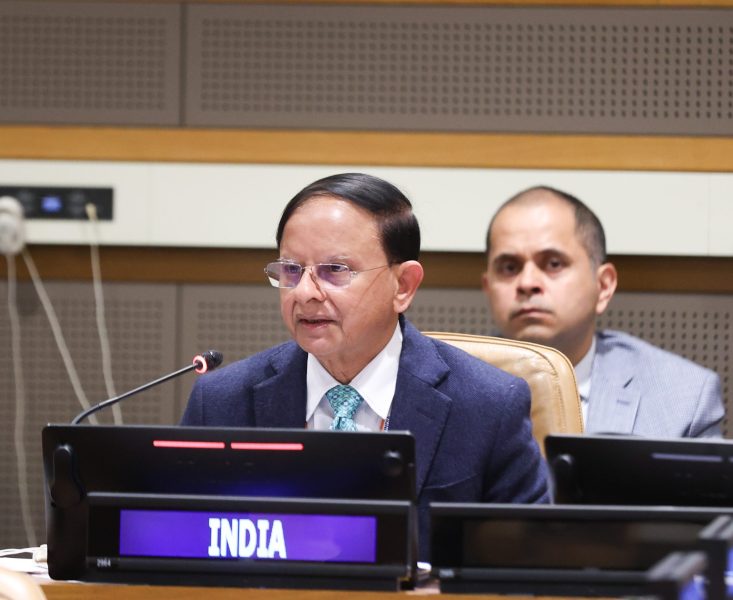
India tells UN it is developing programmes to reduce risk of losses from all hazards

India has told the UN General Assembly that it accords high importance to disaster risk reduction issues and is developing ambitious mitigation programmes to reduce the risk of losses from all hazards, including landslides, floods, earthquakes, heat waves and lightning.
Principal Secretary to Prime Minister Narendra Modi, P K Mishra, said in his address to the Midterm Review of Sendai Framework for Disaster Risk Reduction (2015-2030) at a plenary in the UN General Assembly here on Thursday that in India disaster risk reduction is a “central public policy issue”.
Mishra is leading the Indian delegation at the High-Level Meeting of the General Assembly on the Midterm Review of the implementation of the Sendai Framework for Disaster Risk Reduction 2015-2030 (HLM) that is taking place from May 18-19 at the United Nations Headquarters.
He said that under India’s current presidency of the G20, the group’s members have agreed to establish a Working Group on Disaster Risk Reduction. The five priorities identified by the G20 Working Group early warning for all, resilient infrastructure, improved financing of DRR, systems and capacities for response and build back better, and eco-system based approaches to DRR will provide added impetus to the achievement of Sendai targets globally, he said.
Mishra told the UNGA that India has significantly increased funding earmarked for disaster risk reduction and has brought about landmark changes in its financing architecture to support the entire spectrum of disaster risk management needs disaster risk mitigation, preparedness, response, recovery and reconstruction.
India’s state and local governments have access to about USD 6 billion for disaster risk mitigation over five years (2021-2025). This is in addition to a resource of USD 23 billion meant for preparedness, response and recovery.
In just over a decade, we have been able to reduce the loss of lives from cyclones to less than 2 per cent, he said, adding that India is now developing ambitious mitigation programmes to reduce the risk of losses from all hazards landslides, glacial lake outburst floods, earthquakes, forest fire, heat waves, and lightning.
The high-level meeting provides a platform for member states, the United Nations system partners and other stakeholders to reflect on the findings and recommendations of the Midterm Review, to examine context shifts and emerging issues since 2015.
It identifies course corrections and new initiatives to more effectively address the systemic nature of risk, and realise the outcomes and goals of the Sendai Framework, the 2030 Agenda for Sustainable Development, the Paris Agreement and other agreements, frameworks and conventions.
The Sendai Framework for Disaster Risk Reduction is a landmark 2015 agreement to reduce damage, losses and deaths from natural and man-made hazards by the end of the decade.
The Sendai Framework for Disaster Risk Reduction 2015-2030 (Sendai Framework) was the first major agreement of the post-2015 development agenda and provides member states with concrete actions to protect development gains from the risk of disaster.
Referring to the Coalition for Disaster Resilient Infrastructure, presently co-led by India and the United States, Mishra said the initiative is bringing about transformation in the way infrastructure systems are planned, designed, built, and maintained in the 21st century.
Infrastructure projects are long-term investments. If informed by solid risk assessments, and underpinned by good risk governance, these infrastructure investments can build long-term resilience, he added.
Mishra said India is also working assiduously to improve access to early warning and is implementing Common Alerting Protocol, which will integrate Alert Generating Agencies with Disaster Managers and Telecom Service Providers. This will ensure dissemination of geo-targeted alerts in regional languages to reach, each one of 1.3 billion citizens of our country, he said.
Applauding UN Secretary-General Antonio Guterress’ initiative on Early Warning for All by 2027, Mishra said India’s efforts will contribute to achieving the target set by this timely global initiative.
The UNGA plenary heard from a survivor of the devastating earthquake in February in Turkiye that killed over 50,000 people.
Mishra said that in the spirit of Vasudhaiva Kutumbakam which sees the world as one large inter-connected family, India extended immediate help to our brothers and sisters from Turkiye and Syria by dispatching field hospitals and search and rescue teams as well as medical relief material.
He described this as a true testament to a human-centric global development approach.
He underlined India’s commitment to join efforts to reduce disaster risks at home as well as everywhere on the planet in the spirit of the SDGs: Leave no one behind, leave no place behind, and leave no ecosystem behind.
President of the 77th session of the General Assembly Csaba Korosi said eight years after the adoption of the Sendai Framework, global progress has not kept pace with the urgency of our days as the known number of people affected by disasters has jumped 80-fold since 2015.
“The shocks ignited by unattended risk and amplified by Covid-19, conflict, and climate change have torn through our systems across the world,” the top UN official said.
They have left millions homeless and starving, upended supply chains and laid bare the gross inequities of an international financial order that has often prized profits over people, the UN leader said.
By engaging those most affected by disasters, we can reverse the trends towards inequality, restricted civic space and rising vulnerability.
In short: anticipate risks, calculate, factor in, prepare, prevent, respond rapidly and build the lessons learned into the next action plans, Korosi said.
(Except for the headline, this story has not been edited by The Federal staff and is auto-published from a syndicated feed.)

